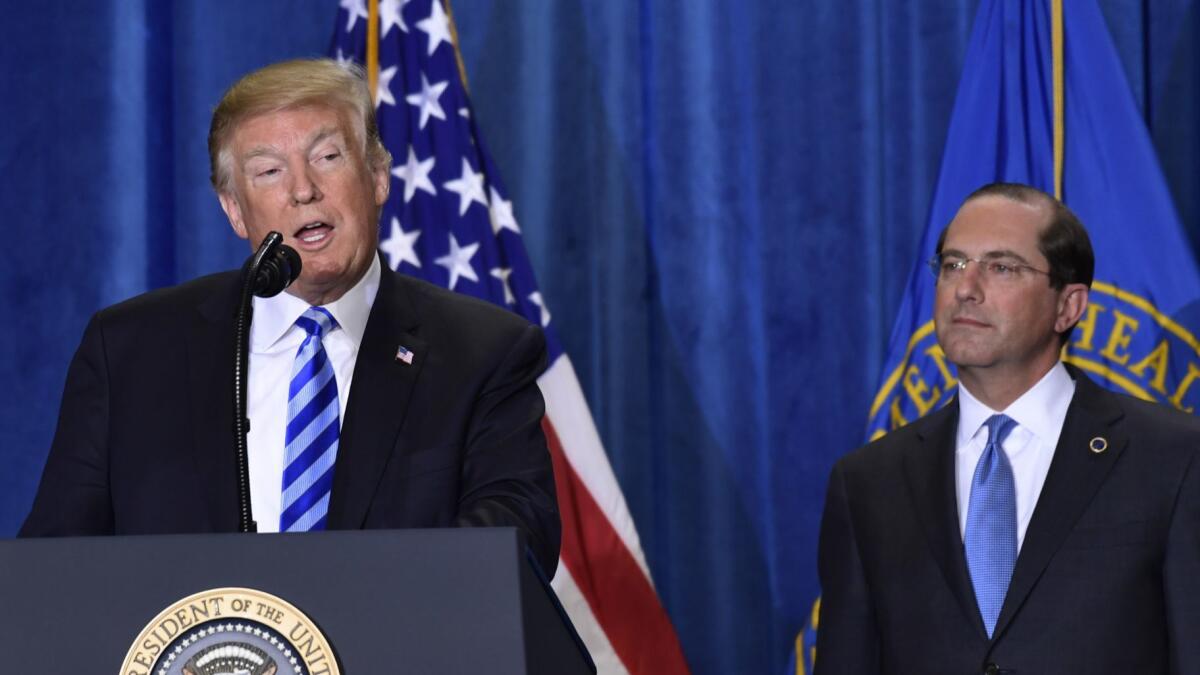Column: The Trump administration unveils a stealth attack on people with preexisting conditions

Trump administration officials apparently are prepared to go to their graves insisting that they did everything possible to protect Americans with preexisting medical conditions, even as they pull out the stops to undermine those protections.
The latest example of this subterfuge came in late October, when the Centers for Medicare and Medicaid Services, known as CMS, issued new rules for states contemplating alterations in the Affordable Care Act.
The administration followed up a few weeks ago with further guidelines. “This administration remains firmly committed to maintaining protections for all Americans with preexisting conditions,” that document says. The “concepts presented here do not open any flexibility for states to undermine these protections.”
The rules are not crystal clear. We’ve tried to figure out how this would work, and it’s not spelled out.
— Karen Pollitz, Kaiser Family Foundation
Unfortunately, according to an analysis by Jennifer Tolbert and Karen Pollitz of the Kaiser Family Foundation, the administration’s proposals could do just that.
“They seem to be aiming to lay out a path for state officials who are interested in undermining the ACA,” Pollitz told me.
The CMS, a part of the Department of Health and Human Services, is responsible for overseeing compliance with the act. Its guide applied to waiver applications under Section 1332 of the act. That section allows states to propose limited changes in Affordable Care Act rules; before approving the waivers, CMS has to find that they don’t disproportionately harm patients with costly conditions, among other restrictions.
The Trump guidelines loosen some of those restrictions materially. Let’s see how.
First, here’s the baseline under the law. Waivers can be approved as long as they provide coverage that, compared with the original program, is at least as comprehensive in covered benefits, at least as affordable (counting premiums and co-pays), covers a “comparable” number of state residents, and doesn’t increase the federal deficit. These are known as “guiderails,” and under the Obama administration they were applied rigorously.
The Trump guidance would redefine “coverage” to include short-term health plans and other plans endorsed by the administration that don’t comply with ACA rules. These plans can impose lifetime benefit caps or fail to provide all 10 essential health benefits required of qualifying ACA plans — including hospitalization, maternity care, prescription drugs, and mental health and substance abuse services.
The new rules are sure to create controversy, and possibly legal counterpunches. Among other problems, they may violate the law, according to Christen Linke Young of the Brookings Institution. Young wrote last month that the administration labeled the changes “interpretive” rather than “legislative.” That exempts the changes from administrative procedures, including advance notice, a comment period and evidence that an agency took the comments into consideration.
But the exemptions are designed only for modest changes in rules, and these look much more significant. The risk, Young writes, is that courts will declare the change invalid.
According to the Trump scheme, the number of people covered under the waiver can include those covered by those substandard plans. In other words, if the same number of residents would have coverage after the waiver as had it before, but many have moved to noncompliant plans, that would be alright.
The new guidance also could allow states to put at disadvantage some high-risk customers in order to make coverage more affordable for others. “A waiver that makes coverage much more affordable for some people and only slightly more costly for a large number of people would likely meet this guardrail.”
These arrangements could pass because CMS proposes to change the rules on how covered populations are counted. The Obama administration interpreted the rules as requiring not merely that the post-waiver program covered at least the same number of people as the original program, but comparable numbers for those with expensive conditions.
In other words, if a new program covered the same number of people overall but shifted the covered population so it included only half as many diabetics, asthmatics or cancer or cardiac patients, it would be rejected under Obama — even if it covered more people with routine medical needs — but could be approved under Trump.
The threat to customers with preexisting conditions comes from several features of the Trump plan, Tolbert and Pollitz say.
One is the administration’s willingness to allow government premium subsidies to be applied to non-qualifying health plans — those short-term and association plans that don’t have to provide the full roster of essential benefits and can reject patients with preexisting conditions.
We’ve written previously about the shortcomings of such plans. The Obama administration limited them to three-month durations and barred their renewals; Trump is allowing them to remain in effect for up to a year, plus annual renewals. One problem with this approach is that it could siphon younger, healthier customers from qualified ACA plans, leaving higher-cost patients behind and driving up their premiums.
Meanwhile, the Trump guidelines would allow states to reallocate premium subsidies, offering younger customers higher subsidies ostensibly to encourage more of them to sign up for coverage. But that would leave older patients with less assistance, a double-whammy for a population more likely to face the expenses of chronic diseases.
The new counting rules could leave patients with costly preexisting conditions out in the cold, Tolbert and Pollitz say. That’s because the rules don’t recognize that the bulk of healthcare expenses are incurred by a small portion of the population — 20% of all patients account for 80% of spending. So a state could meet the Trump standards even if it cut loose some high-cost patients and covered more at the low-cost end of the spectrum.
The changes that Trump’s CMS has instituted in the waiver guidelines are subtle and technical, but significant. They’re also murky.
“The rules are not crystal clear,” Pollitz says. “We’ve tried to figure out how this would work, and it’s not spelled out.”
One threat that looms is that by encouraging states and insurers to take a more “flexible” approach to designing health plans, they’re opening the way for insurers to discourage some customers from applying. An insurer that didn’t want to cover women of childbearing age would offer plans without maternity services. One that didn’t want to deal with substance abuse cases would leave out mental health care. The possibilities are endless, but the endpoint is the same — fewer options for those who need care.
The greatest uncertainty about the rule changes is whether states will use them to dilute the ACA. “What would be the political fallout if a state official were to propose one of these waivers?” Pollitz asks. “Would it raise a stir back home?”
The signs are that the public has become much more concerned about losing the advances they gained via the Affordable Care Act. Take Idaho. There, Republican Gov. Butch Otter issued an executive order in January legalizing insurance plans that could bar people with preexisting conditions. CMS rejected the proposal as a violation of the ACA but offered to work with Idaho to find ways to circumvent the law. In the meantime, however, the state’s voters opted overwhelmingly on election day to expand Medicaid under the ACA. In two other holdout red states, Utah and Nebraska, voters also chose to expand Medicaid.
In Maine, where voters opted for Medicaid expansion last year but were thwarted by right-wing GOP Gov. Paul LePage, who refused to implement the vote, a Democratic governor was voted in, meaning that expansion will now take place.
In other words, the tide seems to be turning in favor of the Affordable Care Act, everywhere but in the Trump White House.
Keep up to date with Michael Hiltzik. Follow @hiltzikm on Twitter, see his Facebook page, or email [email protected].
Return to Michael Hiltzik’s blog.
More to Read
Sign up for Essential California
The most important California stories and recommendations in your inbox every morning.
You may occasionally receive promotional content from the Los Angeles Times.











